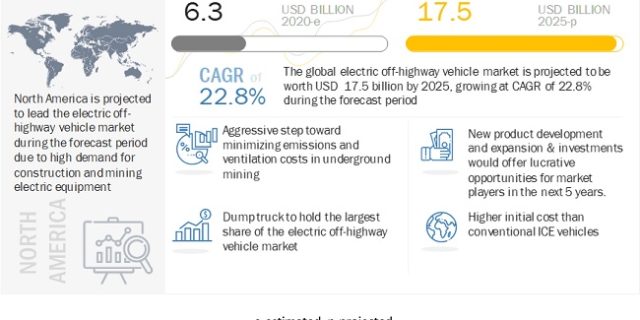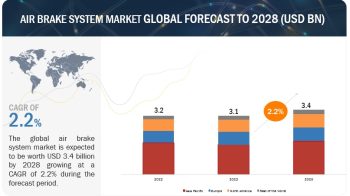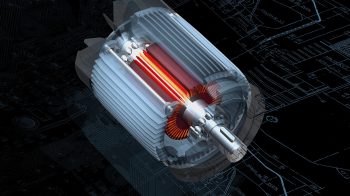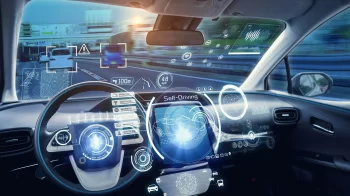
The global Electric Off-highway Vehicle Market is projected to reach USD 17.5 Billion by 2025 from USD 6.3 Billion in 2020, at a CAGR of 22.8% during the forecast period. The growth of this market is primarily driven by the increasing demand to minimize equipment emissions, ventilation costs in underground mining and the preference for the low noise & emission-free construction machines in residential areas. The demand for construction equipment is high across the world. However, the trend of full electrification is limited to mini construction vehicles, including mini excavators and mini loaders. Mining dump trucks require a high-power output and battery capacity to perform heavy-duty mining applications.
Currently available battery technologies do not provide the required power output, resulting in major mining dump trucks operating on hybrid-electric propulsion. The demand for electric construction and mining equipment is higher from North American and European countries as compared to Asian countries due to emission regulations, preference for mini construction equipment, and other governmental policies. Thus, major construction equipment manufacturing companies, including Volvo CE, John Deere, and Caterpillar, are working on several technologies and mini electric construction equipment product prototypes to cater to the demand form North American and European countries.
Download PDF Brochure @ https://www.marketsandmarkets.com/pdfdownloadNew.asp?id=129288251
OPPORTUNITIES: Development of long-range and fast charging battery technology
Most electric off-highway vehicles are currently working on lithium-ion batteries due to their numerous advantages over lead-acid and nickel-metal hydride batteries. However, lithium-ion batteries have several limitations that affect battery performance. Limitations of lithium-ion batteries include issues related to robustness (as they require protection from being overcharged and discharged too far), limited power density, short lifespan (often 500–1,000 charge-discharge cycles before their capacity degrades), performance fluctuations with changing temperatures, rigidness, and high cost.
Many companies are working on the development of fast charging methods and chargers, as powerful DC fast chargers working at 350 kW could charge a 300-kWh battery in just under an hour. But the availability of the required capacity of electricity is still the biggest concern for such developments.
Companies like Volvo CE and Daimler AG are working on the development of fuel cell systems for heavy-duty and electric off-highway vehicles. Volvo CE and Daimler AG formed a 50/50 joint venture intended to establish the way for the superior use and commercialization of hydrogen fuel cell technology in heavy-duty and electric off-highway vehicles. This development is aimed at achieving CO2 neutrality for new vehicles in the European, Japanese, and North American markets.
Such developments are not only expected to strengthen the product portfolio but these would also increase the efficiency of electric off-highway vehicles, offering promising growth opportunities for the global players in the market.
The battery-electric segment is estimated to be the lead the market during the forecast period
The emission and noise control regulations for off-highway equipment have constantly been upgrading at regional levels. According to the EU emission regulations, NOx and particulate matter (PM) levels for off-highway vehicles have been reduced by nearly 95.7% and 97.2%, respectively, from Stage I to Stage V. Similarly, as per the US EPA norms, NOx and PM levels have seen a decline of around 95.6% and 96.2%, respectively, from Tier I to Tier IV. Countries such as China, Japan, South Korea, and India are also expected to follow the same norms in line with the EU and US standards.
Leading equipment manufacturers such as Caterpillar, Volvo CE, Hitachi Construction, and JCB have an adequate mix of product offerings for electric off-highway vehicles. These manufacturers are also undertaking R&D activities to introduce battery-electric off-highway vehicles with high battery capacity and power output in the coming years. Hence, with the growing stringency of emission regulations and desired operational efficiency, the demand for battery-electric off-highway vehicles is expected to continue in the coming years.
Request Free Sample Report @ https://www.marketsandmarkets.com/requestsampleNew.asp?id=129288251
<50hp power output is expected to hold the largest market share
Motors generating an output of <50 hp are generally used in small electric off-highway vehicles. CAT, Komatsu, Volvo CE, Hitachi Construction, John Deere, Sandvik, and Solectrac are the leading OEMs for <50 hp electric off-highway vehicles. Equipment like compact-sized excavators, small and compact loaders, farm tractors, and small dozers are generally equipped with <50 hp motors. The <50 hp power output construction vehicles are mostly used in light construction activities.
The present demand for electric off-highway vehicles is mostly limited to mini construction vehicles due to product availability and limitations of electrification technology. Thus, by power output, the market for <50 hp is projected to be the largest market segment globally.
Key Market Players:
The electric off-highway vehicle market is dominated by few globally established players, such as Caterpillar (US), Komatsu Ltd. (Japan), Volvo Construction Equipment (Volvo CE) (Sweden), Epiroc (Sweden), Sandvik (Sweden), and Hitachi Construction Machinery (Japan), among others. These players mostly adopted the new product development strategy to develop the advanced electric dump truck, electric LHD, electric excavator, electric loader, electric dozer, electric lawnmower, and electric tractor to retain their position in the electric off-highway vehicle market.
Speak to Analyst @ https://www.marketsandmarkets.com/speaktoanalystNew.asp?id=129288251


